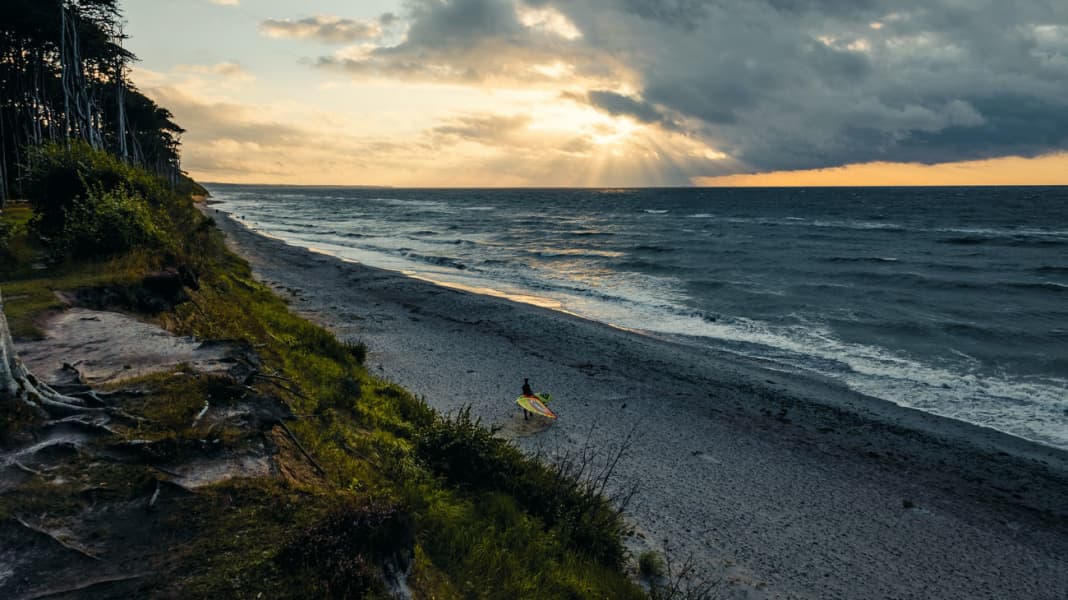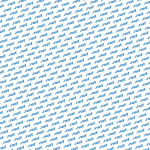Mecklenburg-Vorpommern - welcome to the land to live in! This or something similar is how the state's tourism industry advertises itself. Yet the region's appeal from a windsurfing perspective is obvious just by looking at the map. The country is bordered by what feels like an endless Baltic Sea coastline. In front of it are often picturesque coastal forests, wild cliffs or brightly coloured sandy beaches. In summer, the water of the Baltic Sea is almost turquoise in colour. The Darß, the island of Rügen, Hiddensee - these are places of longing for countless tourists.
Rostock is relatively central on the coast. The young student city is an ideal starting point for trips to the beautiful coast.
Unknown land and sea
For many people from Germany, however, the coast of Mecklenburg-Vorpommern is still a blank slate. Surfers from the south of Germany in particular seem to associate the north with the spots on Fehmarn or the North Sea. Most of them can hardly imagine what the conditions are like in the east. First things first: you won't find a second Hawaii here. But on good days, the Baltic Sea wakes up and often offers slightly more waves here compared to the spots in Schleswig-Holstein. The selection of spots is also comparatively diverse. If you live in Rostock or choose the city as your base camp, you can reach all of the spots described here in under an hour - unless there is a holiday traffic jam on the feeder routes. Unique evening moods on the cliffs of the Mecklenburg Baltic Sea are a regular feature during storms. But it is not only on the island of Rügen that romantics like Caspar David Friedrich can find inspiration in his famous painting of the chalk cliffs. This picturesque, almost breathtakingly beautiful landscape can also be found in Nienhagen, very close to the Hanseatic city of Rostock. The Mecklenburg Baltic Sea coast leads a shadowy existence in the minds of most windsurfers. Yet the state offers its visitors 340 kilometres of really strong Baltic coastline. But where are the best spots actually located? Where does the scene meet in the different wind directions? Where can you find affordable accommodation and good windsurfing infrastructure? surf author and MV-Local Mathias Genkel provides you with all the information you need for your next trip to the sea.
Rostock: The water shimmers turquoise in the sun. Small waves run gently into a huge bay with a white sandy beach. Seagulls sail in the air, their screeching mingling with the sound of the waves. Ferries pass by the harbour entrance on their way to Scandinavia. On the horizon, only the sea. To the west and east, you can see the cliffs and wild coastal forests in the distance. Life pulsates on the beach: Holidaymakers eating fish sandwiches enjoy the sun and let the wind blow around their ears. Beach volleyball is being played. People sunbathe or read newspapers in the beach chairs. Many go swimming - some naked. After all, nudism is part of the cultural heritage here. This certainly takes some getting used to at first. The whole thing resembles a scene that could also take place in the tourist strongholds further south, such as Mallorca or the Canary Islands: Beach bars with music, a good mood, sunshine, a party and holiday feeling.
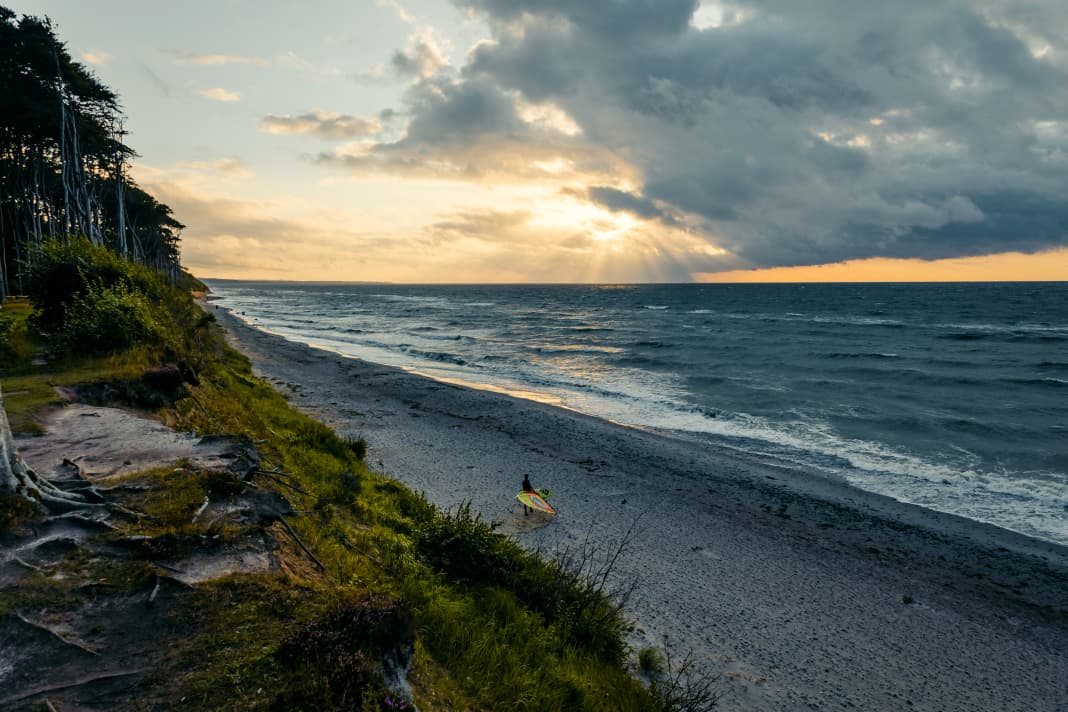





But then there are also those days when people wrap up thickly on the beach and lean against the stiff breeze. Then it is usually much colder - and as a windsurfer, you are confronted with questions on the way to the water such as: "Isn't that too much wind? Isn't it too cold?" But that's exactly the kind of day we windsurfers live for. That's when you find a spot with a nice wave to jump or ride and usually lots of like-minded people too.
But where exactly does the windsurfing scene in Rostock meet? While spots such as Weißenhaus, Heiligenhafen and Dazendorf are on everyone's lips, surfing in Mecklenburg-Vorpommern seems to be somewhat under the radar. There is no real cult spot here. Or maybe there is? Anyone who has surfed the waves in Kühlungsborn on a good day or catapulted themselves into the air in Ahrenshoop knows that the north-east has a lot to offer and has nothing to hide when it comes to conditions on the water. In particular, it is the variety of spots and opportunities to get out on the water that makes the region around Rostock so interesting. Flat water and standing areas, waves for jumping and riding, full but also empty spots - everyone will find a spot to suit their taste here.
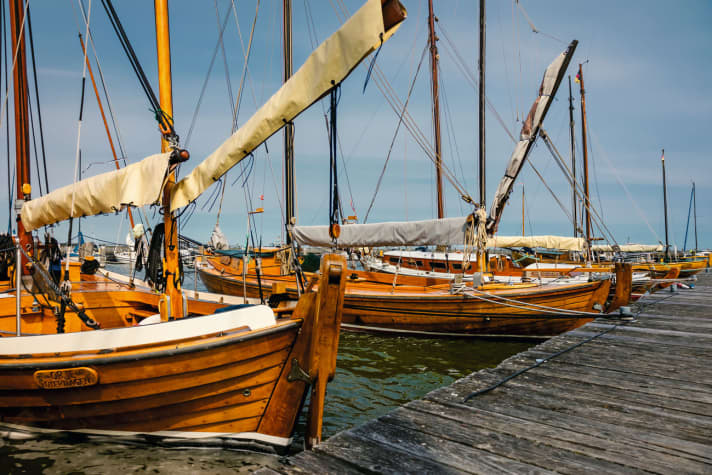
Even I, as a local, have only realised how beautiful the region is in recent years, when I have travelled less. There are dense, rustic coastal forests such as the Darßwald. North of the artists' village of Ahrenshoop, you can still experience unspoilt nature: An unspoilt beach and a dense forest directly adjacent to it, which is dotted with windbreaks. These are trees that lean with the main wind direction and grow at an angle. They thus indicate windy regions and also give their name to Lutz Graichen's custom forge. A walk in a coastal forest is a cure for body and soul. The sound of the sea echoes beneath the crowns of the trees, where birds chirp in spring. The scent of the damp wood of the forest fills the air and at the same time you can feel the salty sea air. When these sensory impressions are joined by a kitschy, beautiful sunset, it is hard to believe that you are on the German Baltic coast.
Here too, it is the contrasts that make the Rostock region so absolutely worth seeing: On the one hand, you have lively seaside resorts such as Warnemünde, Kühlungsborn and Prerow, which seem to be bursting at the seams in the high season and when the weather is nice. On the other hand, especially in the cold season, you will find tranquil and picturesque places for inner contemplation. Even in the high season, there are some spots here that are still spared from the crowds. There are also beautiful places in the immediate vicinity of the university city of Rostock, which is young compared to the rest of the country, that not everyone has on their radar.
The local windsurfing scene is very active. There are several surf shops, festivals close to the beach (Zuparken and Pangea) and lots of beach life in summer. With the Salzhaff (spot guide in surf 07/2019) and the Saaler Bodden, there are also countless shallow water spots close to the city. This spot guide is designed to help you get an overview of the numerous surfing opportunities in the region.
General information:
Journey:Coming from Berlin, take the A19 motorway towards Rostock. From there, you usually take the congested 105 towards Darß or drive via Rostock to the Warnemünde spots. From Hamburg, take the A1 motorway before Lübeck onto the A20. However, as the west-east connection is relatively far to the south, it is often quite a distance on country roads before you reach the spot of your choice. The A105 motorway is often mercilessly overcrowded during the season.
Shops & Schools:
HW-Shapes in Warnemünde www.hw-shapes.de
Hannes Winter is a super friendly and competent water sports enthusiast who will advise you on an equal footing. He sells stylish clothing, skateboards, foils and much more - and has contact with repair workshops.
Supremesurf in Rostock www.supremesurf.de
The shop in the warehouse at Rostock's city harbour offers windsurfing, wing, SUP and kite equipment as well as some fashion. The shop operators have schools in Warnemünde and Saal. They also organise festivals such as Zuparken and Pangea, as well as events such as the Big Days.
- Water sports school Darss www.wassersportschule-darss.de
- Surf & Kite School Dierhagen www.loop-in.net
- Lonosurf www.lonosurf.de
At the campsite in Graal-Müritz, you will find this friendly surf school with its own beach bar and the speciality that all cocktails are made from organic ingredients. Max and Sophia are kind-hearted people.
Custom boards:Wind escaper www.windfluechter-boards.de
Wind, weather & neoprene recommendations:The winter months are the windiest, but this is also the coldest and most uncomfortable time. However, as winters tend to get milder and neoprene technology improves, the season is shifting - you could almost call it a year-round destination, especially as 90 per cent of big days take place between November and March. Where there used to be a winter break, windsurfing is increasingly becoming a year-round sport in northern Germany too. Anyone who has ever desperately searched for a car park in Kühlungsborn on a weekday in January will know what I'm talking about. However, as the Baltic Sea cools down considerably and often only warms up slowly in spring, thick neos, shoes, bonnets and gloves are the order of the day for almost half the year. A good 5/3mm or even better 6/4mm neoprene should be part of your standard equipment. Spring is highly recommended, when the days get longer quickly, the rape is in bloom and the Baltic beaches are not yet completely in the hands of holidaymakers.
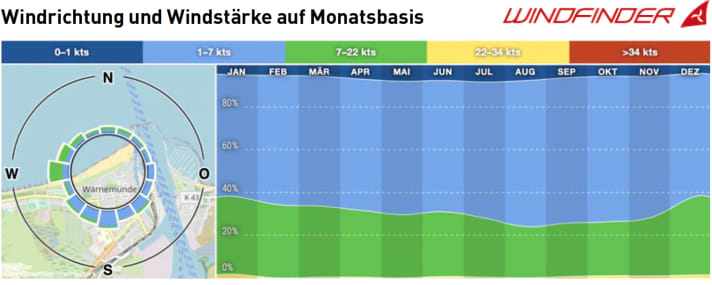
There can be periods of calm in the summer. Westerly winds from low-pressure areas are often somewhat less strong than on the Schleswig-Holstein Baltic Sea coast further north. If the wind in Heiligenhafen is 4.2, it is often 4.7 in Warnemünde. Easterly winds can last for weeks and become thermally stronger on the Bodden in spring. Then it can have wind forces of six, while on the Baltic Sea there is only a gentle breeze.
Alternative programme:If it's raining or a dull day, it's worth making a detour to Karls Erdbeerhof, a kind of family park with numerous attractions. The Marlow bird park is also worth a detour. Rostock Zoo has won several awards. Walks and hikes on the beach or in the coastal forests are a pleasure - especially in the low season. Cycling tours are marvellous. The Baltic Sea cycle route in particular is very busy in the high season. On the Darß, you are often overrun by masses of e-bike gangs. The city of Rostock and its harbour as well as Warnemünde are also worth a visit.
Living & Camping: Wild camping is not tolerated.
- Prerow: Rainbow Camp Prerow
- Warnemünde: There are countless hotels in Warnemünde and Rostock (Hotel Neptun, aja-Strandresort, Yachthafenresidenz Hohe Düne), youth hostels
- Graal-Müritz: Baltic Sea Camp Holiday Park Rostocker Heide
- Kühlungsborn: Campingpark Kühlungsborn
The best windsurfing spots around Rostock:
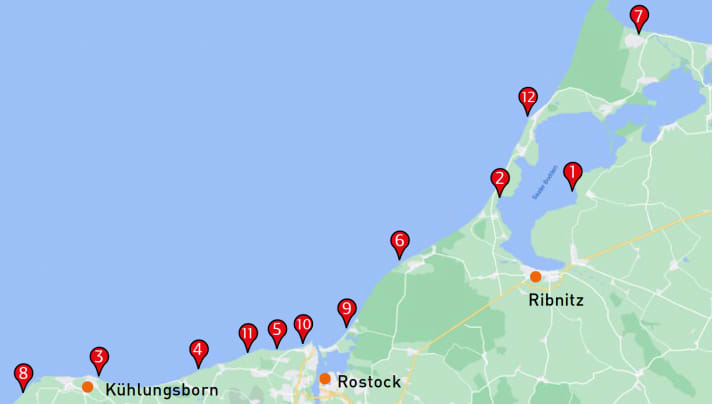
1st hall
The once tranquil spot on the Saaler Bodden has developed into a kite mecca in recent years. The westerly wind blows unchecked over the narrow headland near Wustrow - and then over the Bodden. It is therefore very constant and is thermally amplified in spring and early summer when the sun is shining. Southerly winds no longer come in freely. You should then head for Born, where up to 200 kites can be counted on good days. Nevertheless, even windsurfers can usually find a spot for themselves in the huge standing area. Those who cross further out are often alone, but also have more chop. If a few freestylers get together in a group, you can sometimes conquer one of the shallow bays in front of the reed beds for yourself. The kiters then keep their distance. Travelling from Ribnitz-Damgarten is easy. Take the L2 northwards. Before leaving the village of Saal, turn sharp left and drive along a dirt track across the field towards the entrance to the Bodden. In the season between April and October, you pay a parking fee of around €6, for which you get a meadow to set up on, coffee in the red Supremesurf bus and toilets. Equipment can be hired and a surf course can be booked. Ideal wind direction: WSW-N, flat water, large standing area (no seaweed)
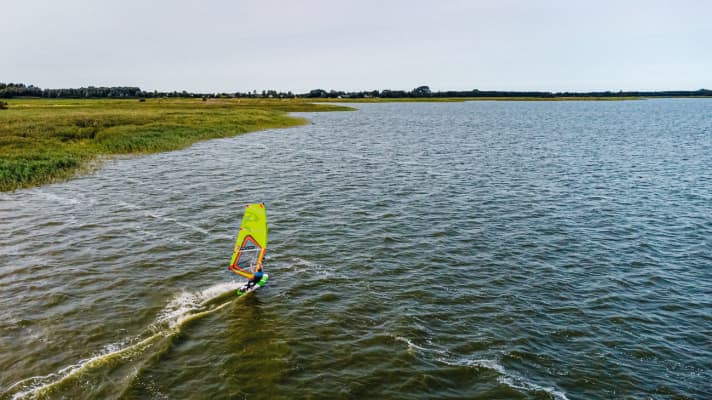
2. dierhagen
The spot at the harbour on the Saaler Bodden is the first port of call in easterly winds, which are sometimes a little thermally strengthened here. Southeast and northeast also work well. There is a large standing area to the north of the harbour. To the south of this you can sometimes find somewhat smoother water. You usually have to cross a little way up from the entry point before you reach the standing area. This can be a bit challenging for beginners. Otherwise, however, Dierhagen is an ideal spot to hone your manoeuvres. Kitesurfing is prohibited here, as many people have dropped their kites into the harbour basin. Windsurfers also need to keep their distance from the fairway and the harbour in order to ensure harmonious coexistence. After the session, there are fresh fish sandwiches in the harbour restaurant. You can park in a sheltered car park about 200 metres from the spot. All in all, Dierhagen is an ideal family spot with all amenities: Meadow for setting up, playground, etc.. Ideal wind direction: SE-NE, shallow water, large standing area (no seaweed). On the Baltic side, you will find a windsurfing school with a standing area at Loop-In (www.loop-in.net). A small wave builds up in strong westerly to south-westerly winds.
3. Kühlungsborn East
Kühlungsborn's boat harbour is the Mecca of wave freaks in the north-east. On good days, the car park here is overcrowded even in winter. There is now even a height limit of two metres. Wave riders come to the spot from Hamburg and Berlin. However, there is a relatively large amount of space on the water, so you don't usually get in each other's way. The problem is the groynes, which can be dangerous when riding the wave at higher water levels. The harbour upwind of the spot keeps the wave in order. It breaks extremely cleanly by Baltic Sea standards and I like to call the spot "Mini-Hanstholm". On some days, however, the wave remains very round and less spectacular. Then Wilhelmshöhe is the better choice. It should have a pure NW to WNW wind. The wind should be at least
The wind should be at least 25 knots so that the wave starts to run. The water level should be taken into account in the forecast. If it is too high, the wave often remains very round. It can therefore sometimes take months for the spot to work well.
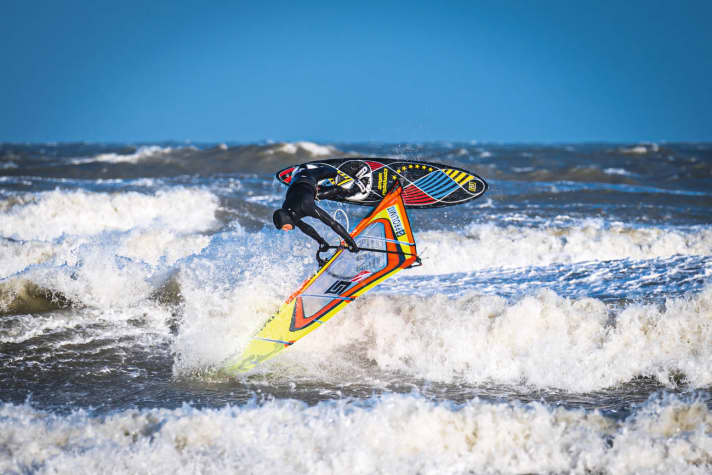
4th Nienhagen
A real secret spot with a mysterious ghostly forest and cliffs - the Baltic seaside resort of Nienhagen is not recognised by many water sports enthusiasts. However, there are also beautiful waves here and plenty of space on the water. The spot works from WSW to WNW and from ONE to EAST. Ideal wind direction: WSW-WNW and ONE-O, chop up to max. 2.5 metre waves.
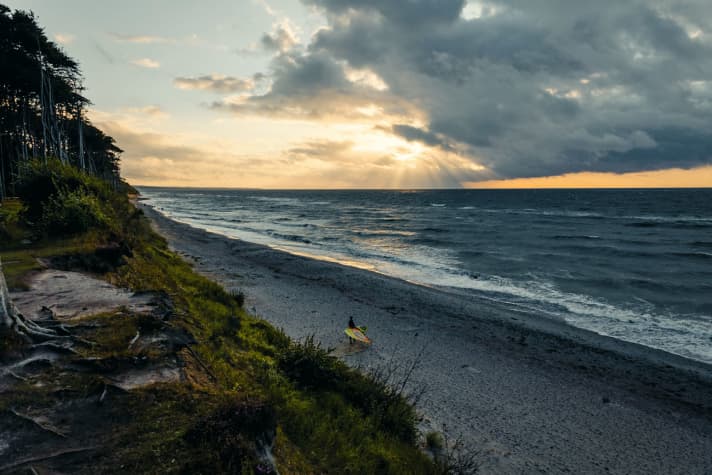
5. Wilhelmshöhe
Wilhelmshöhe is the top wave spot on the Rostock scene in WNW and NW winds. You park a little away from the beach, which can be reached by a short walk through a picturesque wooded area. The coast here is a little steeper and lined with trees, so the wind direction has to be just right to ensure that there is no cover or even windward jamming. There are a few large stones right at the front, which can also be washed over depending on the water level. Further downwind, there are also a few stones in the surf zone, but they are surprisingly rare. The current here often moves strongly with the wind direction, the wave usually breaks hollow on the flat sandbank in front and then a little nicer further out. You should bring some experience with you. Then beautiful wave rides and jumps are possible. From the hotel terrace, you have a great view of the spot, can check the conditions and order something to eat or drink. Compared to Kühlungsborn Ost, the wave breaks less cleanly here, but is often more powerful and can be a bit better for jumping. Ideal wind direction: WNW-NW, chop to wave (<2.5m)
6th Graal-Müritz
The spa town, which is located around 25 kilometres north-east of Rostock, is only on the radar of a few water sports enthusiasts, as they prefer to head straight to the Darß. Yet it is picturesquely beautiful here. At the western end of the town there is a large forest and a lovely campsite with a friendly surf school. The groynes have just been renewed and can be dangerous when the water level is high. Otherwise, you really feel like you're on holiday here when the sun is shining. South-westerly to westerly winds are ideal for the spot at the campsite. Further east at Mittelweg it should be a pure westerly wind. The waves here are often a little disappointing. Ideal wind direction: WSW and NE, chop to waves up to max. 2.5 metres.
7 Prerow
Somewhat forgotten, Prerow offers a picturesque ambience with a white sandy beach and beautiful nature. While surfing here, you can look out over the Darßer Ort, a nature reserve that must not be entered. Prerow works best with an easterly wind. Depending on the strength of the wind, there are then some waves that break over the numerous sandbanks. But wave beginners will also find a clean, small wave to play with in the north-west. Ideal wind direction: OSO-NE; NNW-N, chop to wave (<1.5m).
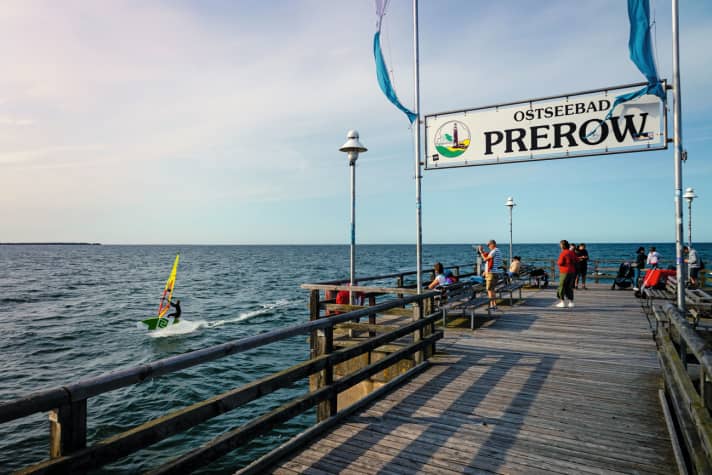
8th Kägsdorf
This is where the legendary Zuparken festival takes place - but when the wind blows from the south-west, the spot is also parked up with numerous surf buses on normal weekends. The beach is small and was completely washed away this winter, but the waves here can be nice and clean. There are no groynes and no rocks in the water. Only the current sometimes pulls quite strongly on the fin. Ideal wind direction: SW-WSW, chop to wave (<2.5m)
9th Markgrafenheide
This spot is also often simply ignored. But it also works here when it's very southerly. Due to its location in a bay, the wind doesn't always come in quite as strong as at the other spots. Margrafenheide is a good alternative spot if you don't have much time. Or for surfers for whom the Darß is too crowded. Ideal wind direction: SW-WSW; NNW- NNO, chop to wave (<2.5m)
10 Warnemünde
Lined by a fine white sandy beach, the bay of Warnemünde stretches for almost three kilometres. Rostock's city beach is surprisingly wide and attracts numerous holidaymakers from all over Germany in the high season. The entry zones are then marked with buoys. Nevertheless, consideration for swimmers is always required. The spot in front of the Supremesurf Beachhouse used to be the number one windsurf wave spot in the region. However, the trend sport of kitesurfing has somewhat displaced windsurfers here. When the wind is good, there are numerous kites here. The spot also tolerates a pure westerly wind, which can be an advantage compared to Wilhelmshöhe (the spot where the windsurfers have now moved). In addition, the ground here consists of the finest sand. The groynes end a little to windward of the entrance, so there are no dangers in the water. However, you should stay away from the large harbour mole to leeward. Warnemünde also works in a north-easterly with a fairly clean wave. However, the wind tends to shift out of the bay if it gets too easterly. Then Kühlungsborn or the Darß is the better choice. Ideal wind direction: W- WNW, chop to wave (<2.5m)
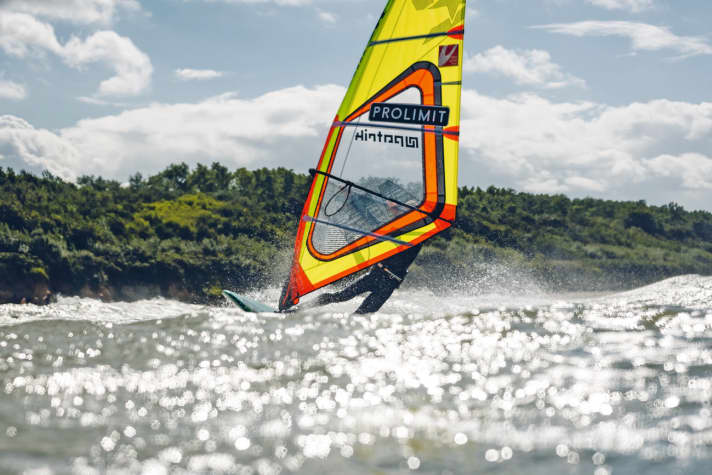
11th Elmenhorst
At the legendary Elmenhorst spot, you can actually see a tower on the north-western horizon. Framed by the cliffs, the wind direction must be just right here. West-south-west to west is ideal. If it gets too southerly, the cliffs will interfere. Then you have to head for Kägsdorf or Ahrenshoop. Here, too, there are numerous stones in and around the water, so caution is advised. The wave often remains relatively small, even during storms. However, the spot can be fun, has no groynes and its proximity to the city makes it an ideal
ideal starting point for the Rostock scene when it's too south for Wilhelmshöhe. In the meantime, the car park has already been overcrowded on good days, so free parking will soon be a thing of the past. From the car park, you have to carry your equipment around 150 metres through a small wooded area. Ideal wind direction: WSW-W; NNO-NE, chop to wave (<2.5m)
12th Ahrenshoop
The wave spot for the south-west has long ceased to be an insider tip. The RedBull BigDays with none other than Philip Köster have already been held at the spot on the Steinbuhne, known as the breakwater. The sandbanks in Ahrenshoop often change dramatically with the storms. The wave at the breakwater spot often breaks very round. However, this spot can handle much more south than the spot further north at the clinic. A powerful breaking wave has often been found here in recent years. Unfortunately, the sandbank has recently changed so that the wave now breaks closer to the groynes and is less usable. Ideal wind direction: SW-WSW, chop to wave (<2.5m)
